Accounting Policies and Technology Assets: CSL Ltd Case Study Report
VerifiedAdded on 2023/03/20
|7
|1789
|73
Report
AI Summary
This report analyzes the accounting policies employed by CSL Ltd, a biopharmaceutical company, concerning research and development and technology assets. It examines the company's treatment of various expenditures related to technology, including the recognition of intangible assets under AASB 138. The report highlights the differences in how CSL Ltd treats the development costs of technology assets compared to tangible assets, like plant and machinery. Furthermore, it discusses the implications of these accounting practices on the firm's financial reports, emphasizing the importance of relevant expenditures on technology assets for stakeholders, investors, and management decision-making. The report also explores the consequences of the financial report for the stakeholders and the importance of revealing the information of the technology assets.
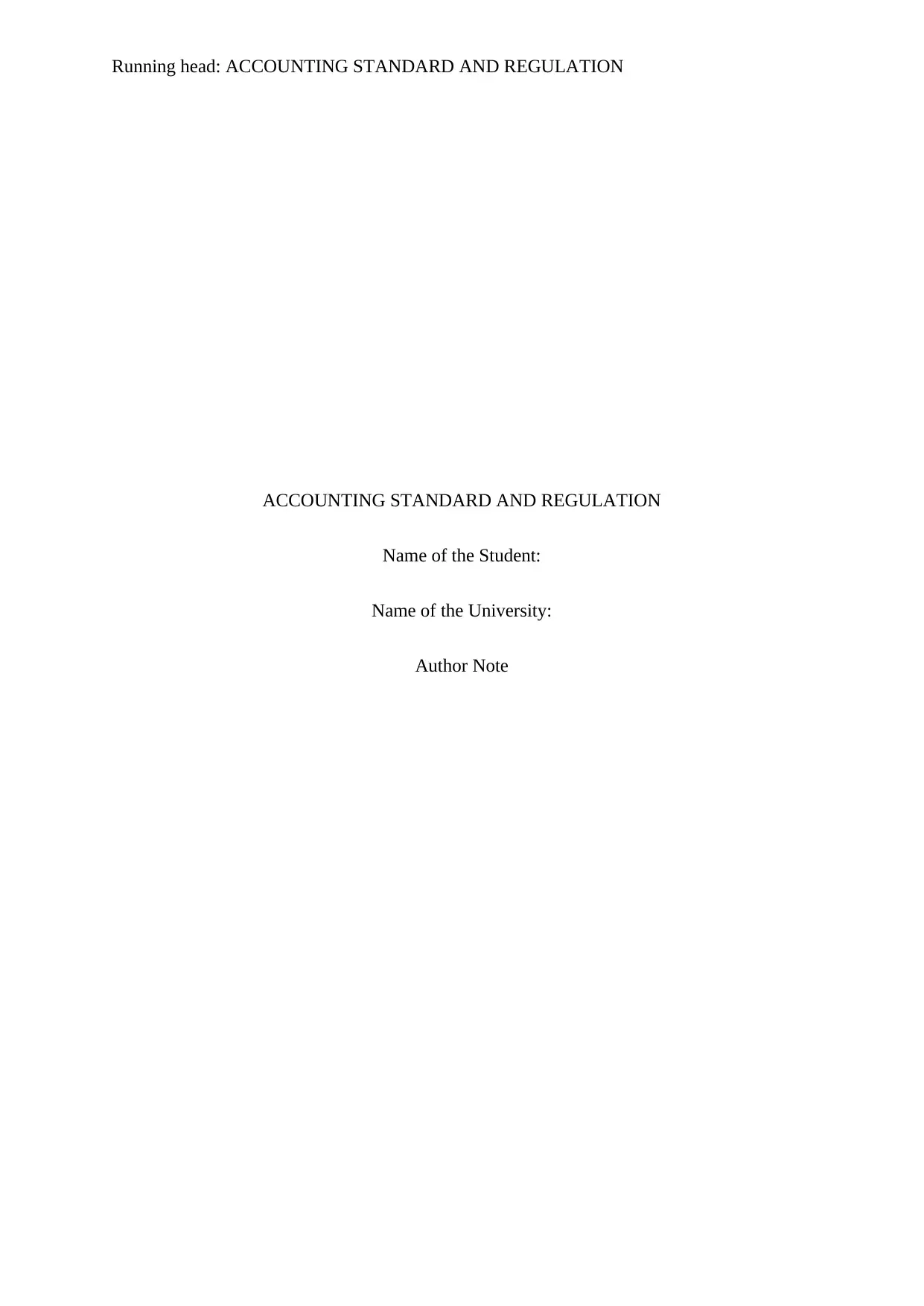
Running head: ACCOUNTING STANDARD AND REGULATION
ACCOUNTING STANDARD AND REGULATION
Name of the Student:
Name of the University:
Author Note
ACCOUNTING STANDARD AND REGULATION
Name of the Student:
Name of the University:
Author Note
Paraphrase This Document
Need a fresh take? Get an instant paraphrase of this document with our AI Paraphraser
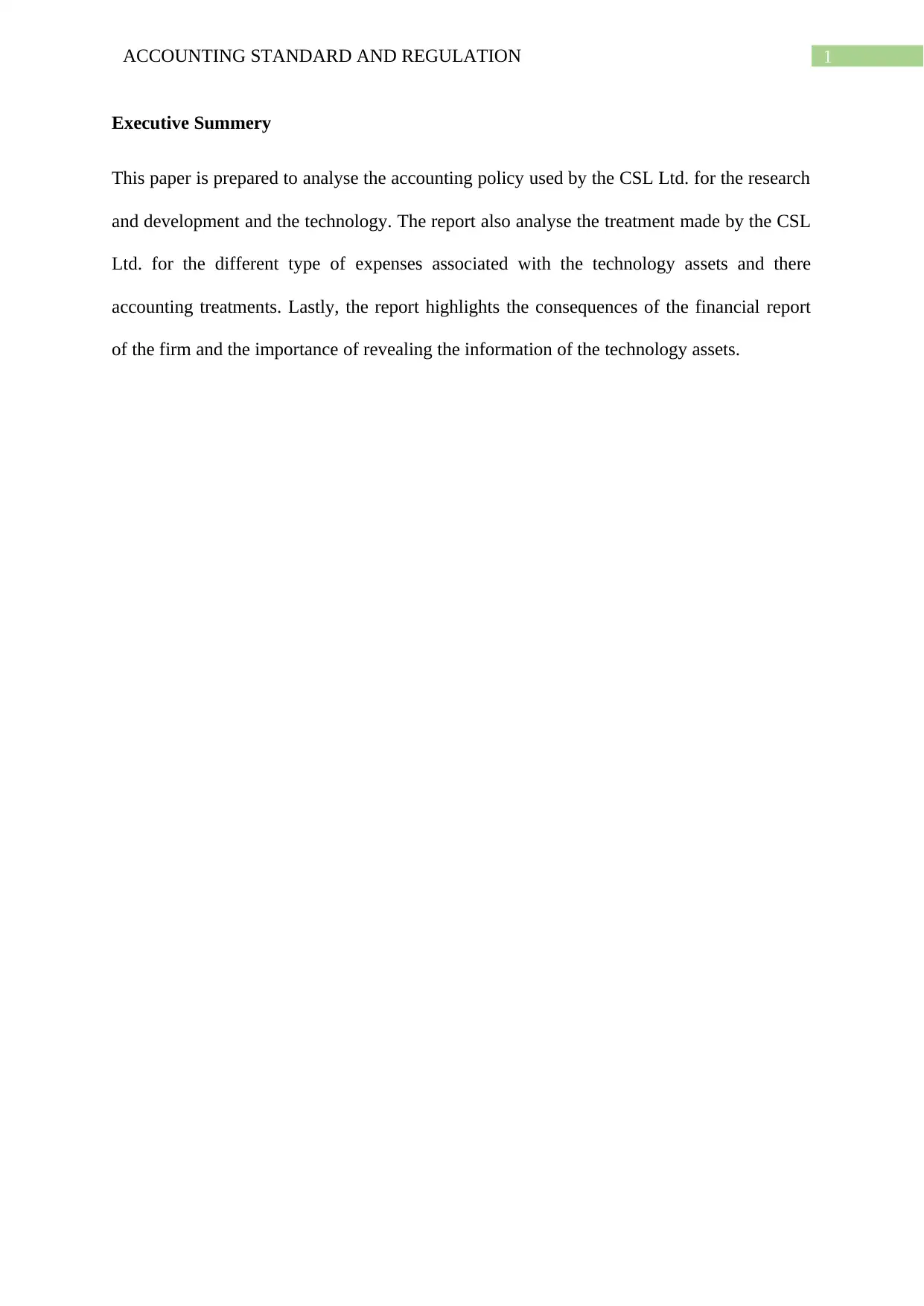
1ACCOUNTING STANDARD AND REGULATION
Executive Summery
This paper is prepared to analyse the accounting policy used by the CSL Ltd. for the research
and development and the technology. The report also analyse the treatment made by the CSL
Ltd. for the different type of expenses associated with the technology assets and there
accounting treatments. Lastly, the report highlights the consequences of the financial report
of the firm and the importance of revealing the information of the technology assets.
Executive Summery
This paper is prepared to analyse the accounting policy used by the CSL Ltd. for the research
and development and the technology. The report also analyse the treatment made by the CSL
Ltd. for the different type of expenses associated with the technology assets and there
accounting treatments. Lastly, the report highlights the consequences of the financial report
of the firm and the importance of revealing the information of the technology assets.
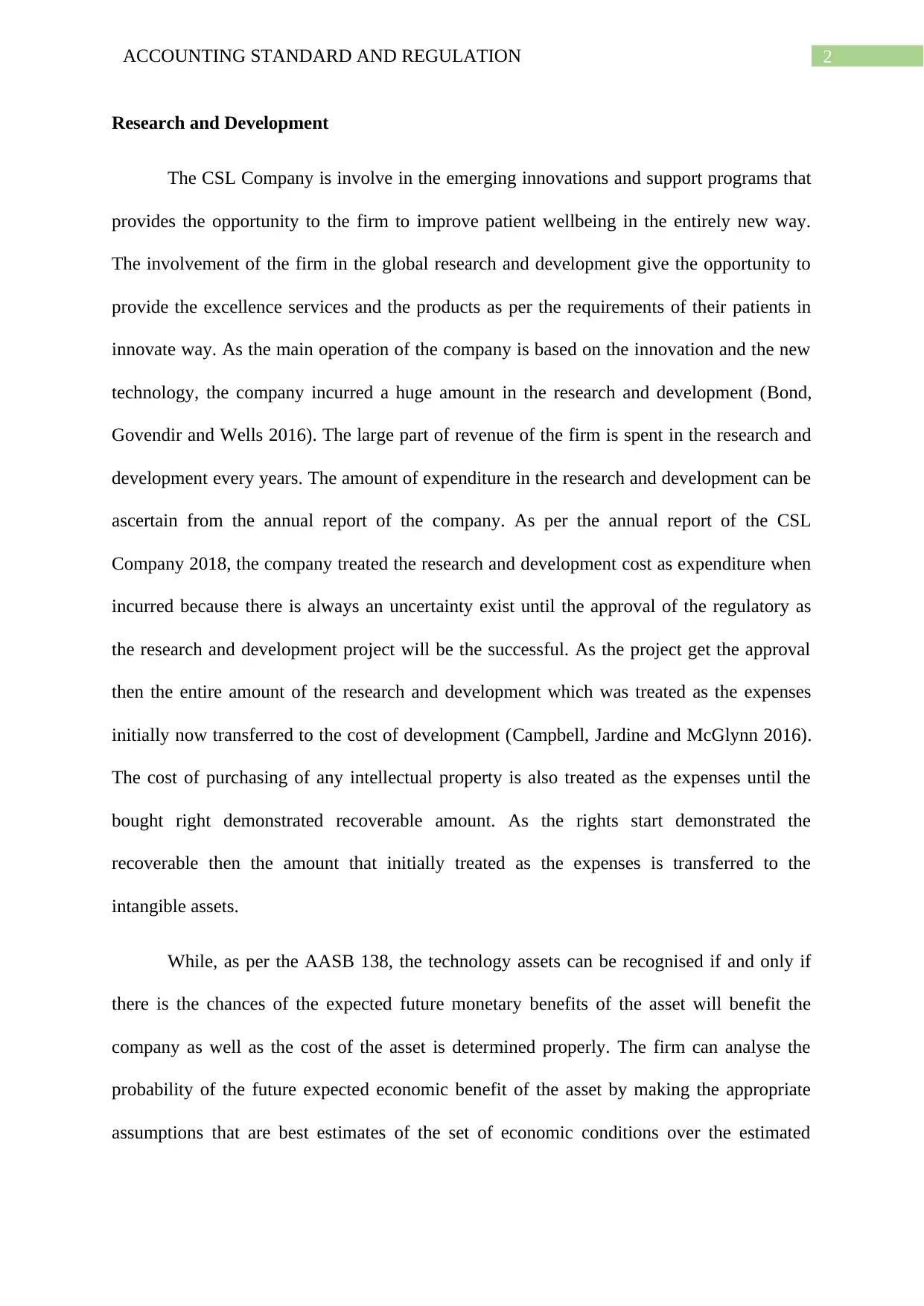
2ACCOUNTING STANDARD AND REGULATION
Research and Development
The CSL Company is involve in the emerging innovations and support programs that
provides the opportunity to the firm to improve patient wellbeing in the entirely new way.
The involvement of the firm in the global research and development give the opportunity to
provide the excellence services and the products as per the requirements of their patients in
innovate way. As the main operation of the company is based on the innovation and the new
technology, the company incurred a huge amount in the research and development (Bond,
Govendir and Wells 2016). The large part of revenue of the firm is spent in the research and
development every years. The amount of expenditure in the research and development can be
ascertain from the annual report of the company. As per the annual report of the CSL
Company 2018, the company treated the research and development cost as expenditure when
incurred because there is always an uncertainty exist until the approval of the regulatory as
the research and development project will be the successful. As the project get the approval
then the entire amount of the research and development which was treated as the expenses
initially now transferred to the cost of development (Campbell, Jardine and McGlynn 2016).
The cost of purchasing of any intellectual property is also treated as the expenses until the
bought right demonstrated recoverable amount. As the rights start demonstrated the
recoverable then the amount that initially treated as the expenses is transferred to the
intangible assets.
While, as per the AASB 138, the technology assets can be recognised if and only if
there is the chances of the expected future monetary benefits of the asset will benefit the
company as well as the cost of the asset is determined properly. The firm can analyse the
probability of the future expected economic benefit of the asset by making the appropriate
assumptions that are best estimates of the set of economic conditions over the estimated
Research and Development
The CSL Company is involve in the emerging innovations and support programs that
provides the opportunity to the firm to improve patient wellbeing in the entirely new way.
The involvement of the firm in the global research and development give the opportunity to
provide the excellence services and the products as per the requirements of their patients in
innovate way. As the main operation of the company is based on the innovation and the new
technology, the company incurred a huge amount in the research and development (Bond,
Govendir and Wells 2016). The large part of revenue of the firm is spent in the research and
development every years. The amount of expenditure in the research and development can be
ascertain from the annual report of the company. As per the annual report of the CSL
Company 2018, the company treated the research and development cost as expenditure when
incurred because there is always an uncertainty exist until the approval of the regulatory as
the research and development project will be the successful. As the project get the approval
then the entire amount of the research and development which was treated as the expenses
initially now transferred to the cost of development (Campbell, Jardine and McGlynn 2016).
The cost of purchasing of any intellectual property is also treated as the expenses until the
bought right demonstrated recoverable amount. As the rights start demonstrated the
recoverable then the amount that initially treated as the expenses is transferred to the
intangible assets.
While, as per the AASB 138, the technology assets can be recognised if and only if
there is the chances of the expected future monetary benefits of the asset will benefit the
company as well as the cost of the asset is determined properly. The firm can analyse the
probability of the future expected economic benefit of the asset by making the appropriate
assumptions that are best estimates of the set of economic conditions over the estimated
⊘ This is a preview!⊘
Do you want full access?
Subscribe today to unlock all pages.

Trusted by 1+ million students worldwide
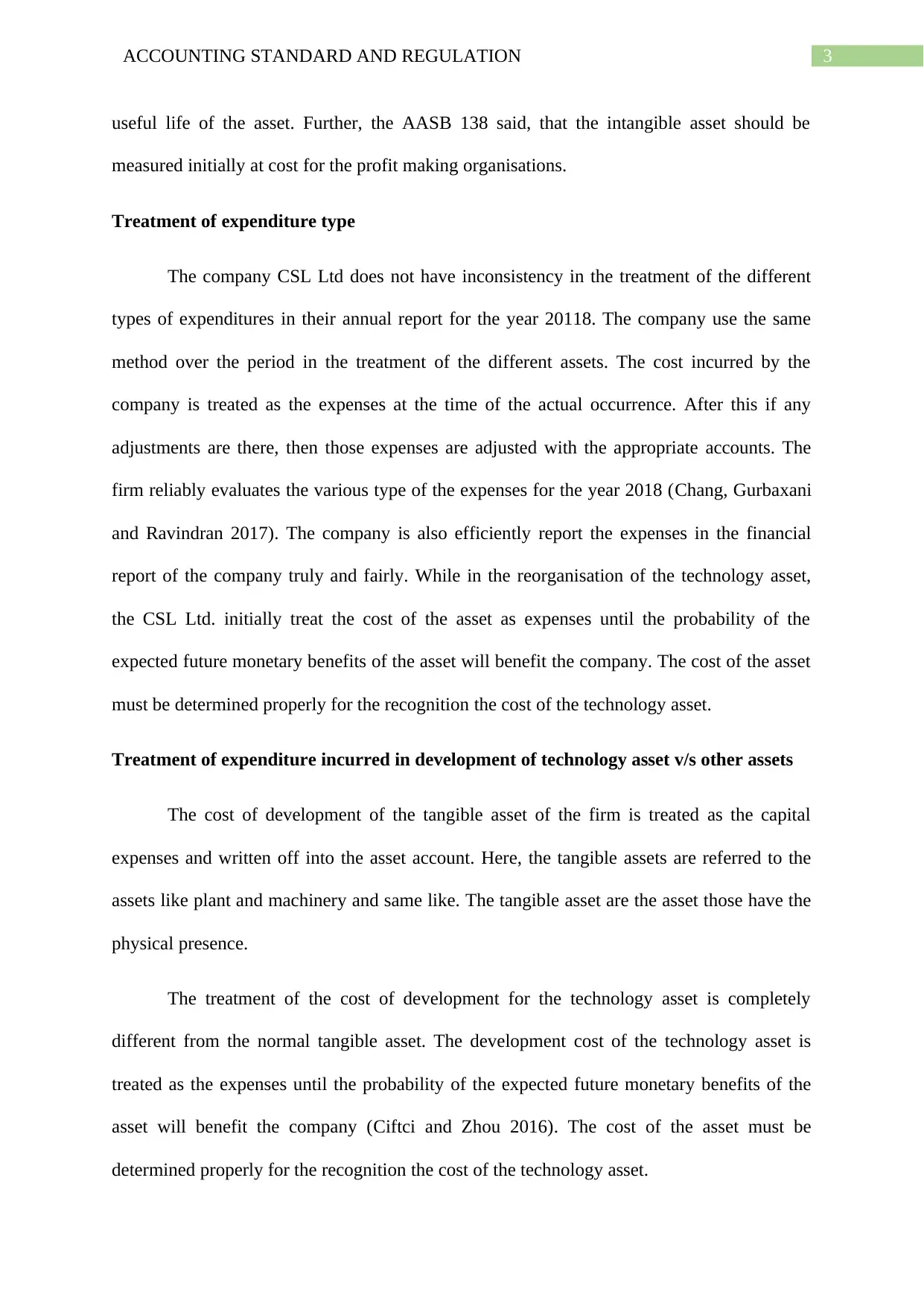
3ACCOUNTING STANDARD AND REGULATION
useful life of the asset. Further, the AASB 138 said, that the intangible asset should be
measured initially at cost for the profit making organisations.
Treatment of expenditure type
The company CSL Ltd does not have inconsistency in the treatment of the different
types of expenditures in their annual report for the year 20118. The company use the same
method over the period in the treatment of the different assets. The cost incurred by the
company is treated as the expenses at the time of the actual occurrence. After this if any
adjustments are there, then those expenses are adjusted with the appropriate accounts. The
firm reliably evaluates the various type of the expenses for the year 2018 (Chang, Gurbaxani
and Ravindran 2017). The company is also efficiently report the expenses in the financial
report of the company truly and fairly. While in the reorganisation of the technology asset,
the CSL Ltd. initially treat the cost of the asset as expenses until the probability of the
expected future monetary benefits of the asset will benefit the company. The cost of the asset
must be determined properly for the recognition the cost of the technology asset.
Treatment of expenditure incurred in development of technology asset v/s other assets
The cost of development of the tangible asset of the firm is treated as the capital
expenses and written off into the asset account. Here, the tangible assets are referred to the
assets like plant and machinery and same like. The tangible asset are the asset those have the
physical presence.
The treatment of the cost of development for the technology asset is completely
different from the normal tangible asset. The development cost of the technology asset is
treated as the expenses until the probability of the expected future monetary benefits of the
asset will benefit the company (Ciftci and Zhou 2016). The cost of the asset must be
determined properly for the recognition the cost of the technology asset.
useful life of the asset. Further, the AASB 138 said, that the intangible asset should be
measured initially at cost for the profit making organisations.
Treatment of expenditure type
The company CSL Ltd does not have inconsistency in the treatment of the different
types of expenditures in their annual report for the year 20118. The company use the same
method over the period in the treatment of the different assets. The cost incurred by the
company is treated as the expenses at the time of the actual occurrence. After this if any
adjustments are there, then those expenses are adjusted with the appropriate accounts. The
firm reliably evaluates the various type of the expenses for the year 2018 (Chang, Gurbaxani
and Ravindran 2017). The company is also efficiently report the expenses in the financial
report of the company truly and fairly. While in the reorganisation of the technology asset,
the CSL Ltd. initially treat the cost of the asset as expenses until the probability of the
expected future monetary benefits of the asset will benefit the company. The cost of the asset
must be determined properly for the recognition the cost of the technology asset.
Treatment of expenditure incurred in development of technology asset v/s other assets
The cost of development of the tangible asset of the firm is treated as the capital
expenses and written off into the asset account. Here, the tangible assets are referred to the
assets like plant and machinery and same like. The tangible asset are the asset those have the
physical presence.
The treatment of the cost of development for the technology asset is completely
different from the normal tangible asset. The development cost of the technology asset is
treated as the expenses until the probability of the expected future monetary benefits of the
asset will benefit the company (Ciftci and Zhou 2016). The cost of the asset must be
determined properly for the recognition the cost of the technology asset.
Paraphrase This Document
Need a fresh take? Get an instant paraphrase of this document with our AI Paraphraser
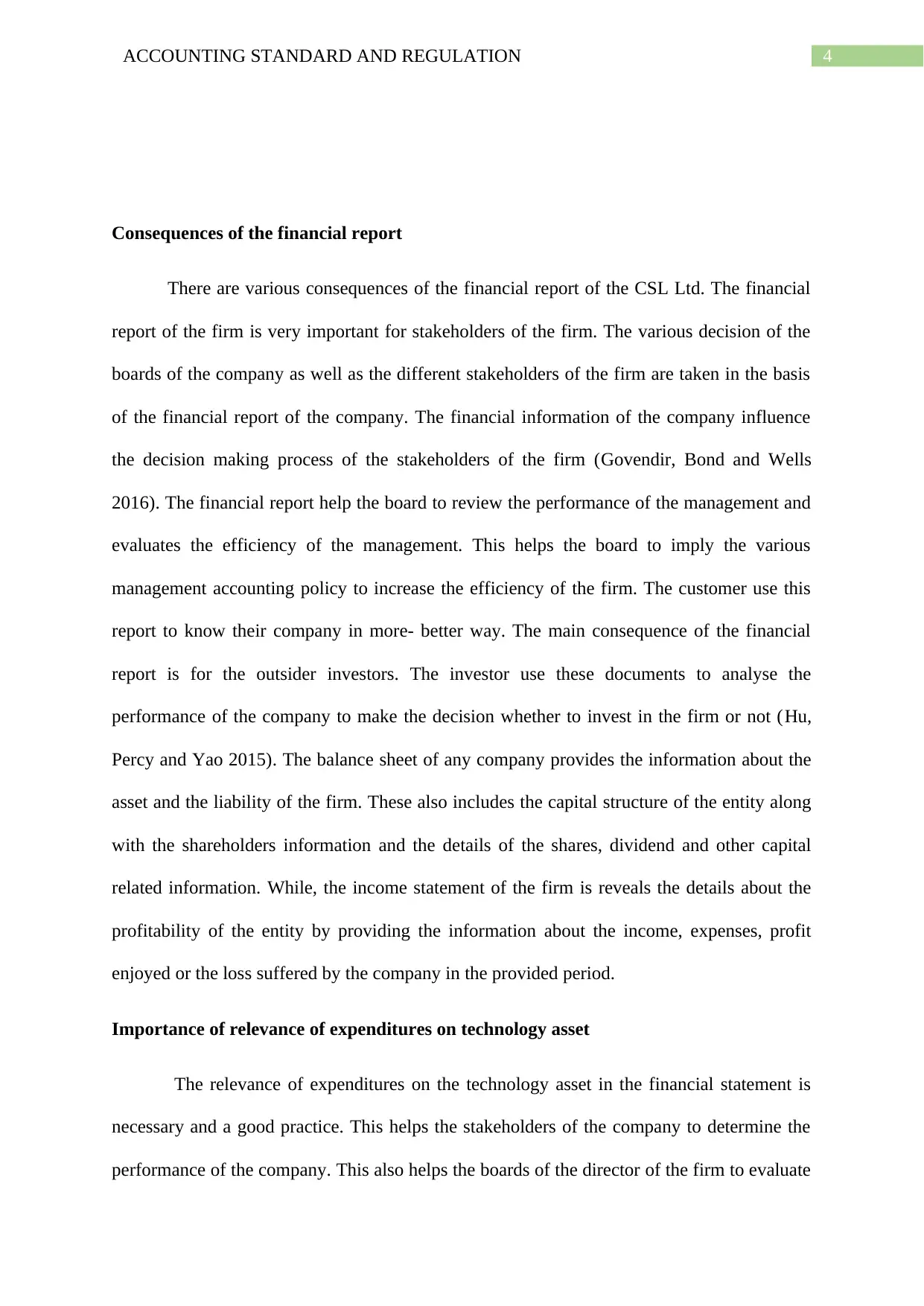
4ACCOUNTING STANDARD AND REGULATION
Consequences of the financial report
There are various consequences of the financial report of the CSL Ltd. The financial
report of the firm is very important for stakeholders of the firm. The various decision of the
boards of the company as well as the different stakeholders of the firm are taken in the basis
of the financial report of the company. The financial information of the company influence
the decision making process of the stakeholders of the firm (Govendir, Bond and Wells
2016). The financial report help the board to review the performance of the management and
evaluates the efficiency of the management. This helps the board to imply the various
management accounting policy to increase the efficiency of the firm. The customer use this
report to know their company in more- better way. The main consequence of the financial
report is for the outsider investors. The investor use these documents to analyse the
performance of the company to make the decision whether to invest in the firm or not (Hu,
Percy and Yao 2015). The balance sheet of any company provides the information about the
asset and the liability of the firm. These also includes the capital structure of the entity along
with the shareholders information and the details of the shares, dividend and other capital
related information. While, the income statement of the firm is reveals the details about the
profitability of the entity by providing the information about the income, expenses, profit
enjoyed or the loss suffered by the company in the provided period.
Importance of relevance of expenditures on technology asset
The relevance of expenditures on the technology asset in the financial statement is
necessary and a good practice. This helps the stakeholders of the company to determine the
performance of the company. This also helps the boards of the director of the firm to evaluate
Consequences of the financial report
There are various consequences of the financial report of the CSL Ltd. The financial
report of the firm is very important for stakeholders of the firm. The various decision of the
boards of the company as well as the different stakeholders of the firm are taken in the basis
of the financial report of the company. The financial information of the company influence
the decision making process of the stakeholders of the firm (Govendir, Bond and Wells
2016). The financial report help the board to review the performance of the management and
evaluates the efficiency of the management. This helps the board to imply the various
management accounting policy to increase the efficiency of the firm. The customer use this
report to know their company in more- better way. The main consequence of the financial
report is for the outsider investors. The investor use these documents to analyse the
performance of the company to make the decision whether to invest in the firm or not (Hu,
Percy and Yao 2015). The balance sheet of any company provides the information about the
asset and the liability of the firm. These also includes the capital structure of the entity along
with the shareholders information and the details of the shares, dividend and other capital
related information. While, the income statement of the firm is reveals the details about the
profitability of the entity by providing the information about the income, expenses, profit
enjoyed or the loss suffered by the company in the provided period.
Importance of relevance of expenditures on technology asset
The relevance of expenditures on the technology asset in the financial statement is
necessary and a good practice. This helps the stakeholders of the company to determine the
performance of the company. This also helps the boards of the director of the firm to evaluate
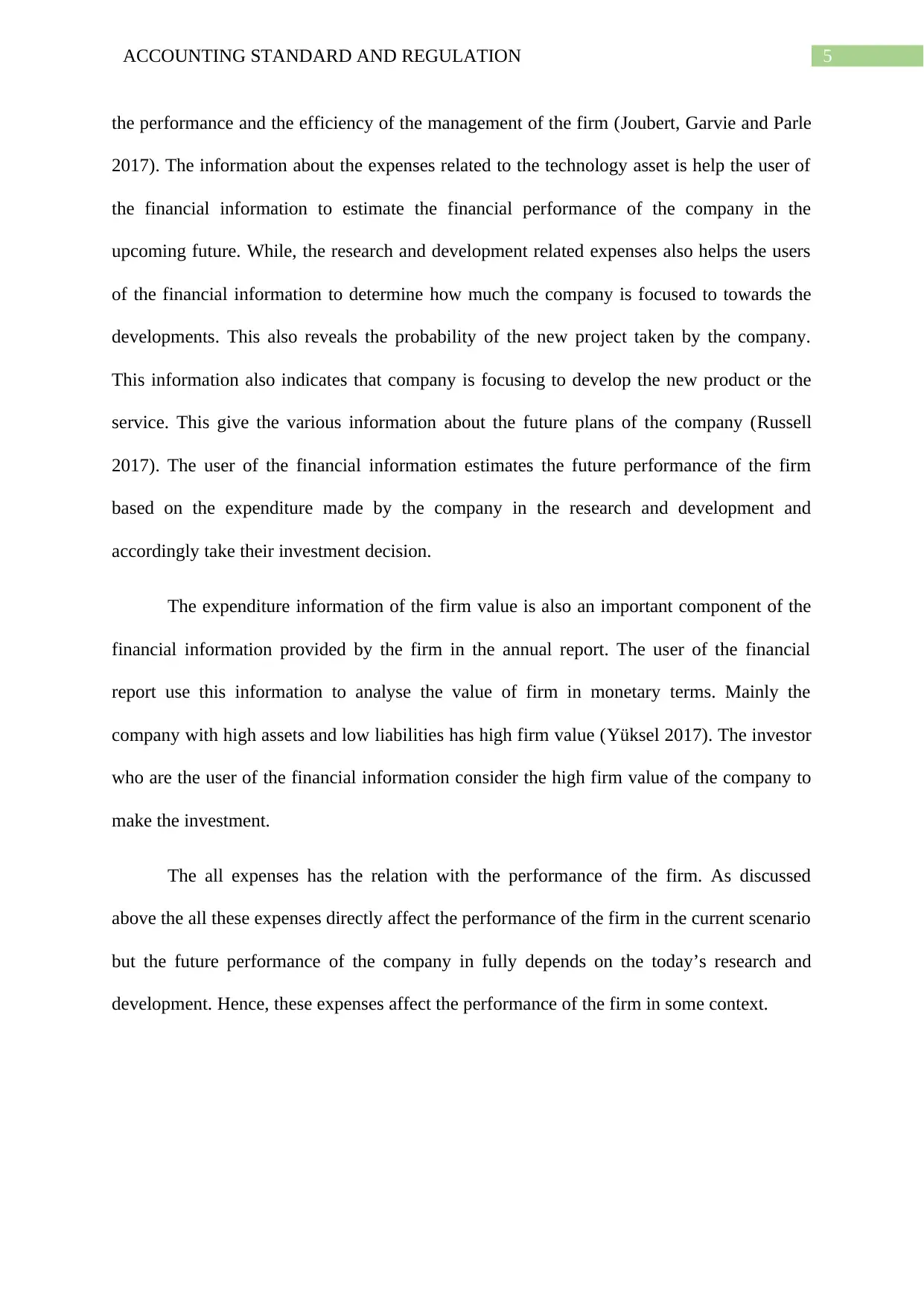
5ACCOUNTING STANDARD AND REGULATION
the performance and the efficiency of the management of the firm (Joubert, Garvie and Parle
2017). The information about the expenses related to the technology asset is help the user of
the financial information to estimate the financial performance of the company in the
upcoming future. While, the research and development related expenses also helps the users
of the financial information to determine how much the company is focused to towards the
developments. This also reveals the probability of the new project taken by the company.
This information also indicates that company is focusing to develop the new product or the
service. This give the various information about the future plans of the company (Russell
2017). The user of the financial information estimates the future performance of the firm
based on the expenditure made by the company in the research and development and
accordingly take their investment decision.
The expenditure information of the firm value is also an important component of the
financial information provided by the firm in the annual report. The user of the financial
report use this information to analyse the value of firm in monetary terms. Mainly the
company with high assets and low liabilities has high firm value (Yüksel 2017). The investor
who are the user of the financial information consider the high firm value of the company to
make the investment.
The all expenses has the relation with the performance of the firm. As discussed
above the all these expenses directly affect the performance of the firm in the current scenario
but the future performance of the company in fully depends on the today’s research and
development. Hence, these expenses affect the performance of the firm in some context.
the performance and the efficiency of the management of the firm (Joubert, Garvie and Parle
2017). The information about the expenses related to the technology asset is help the user of
the financial information to estimate the financial performance of the company in the
upcoming future. While, the research and development related expenses also helps the users
of the financial information to determine how much the company is focused to towards the
developments. This also reveals the probability of the new project taken by the company.
This information also indicates that company is focusing to develop the new product or the
service. This give the various information about the future plans of the company (Russell
2017). The user of the financial information estimates the future performance of the firm
based on the expenditure made by the company in the research and development and
accordingly take their investment decision.
The expenditure information of the firm value is also an important component of the
financial information provided by the firm in the annual report. The user of the financial
report use this information to analyse the value of firm in monetary terms. Mainly the
company with high assets and low liabilities has high firm value (Yüksel 2017). The investor
who are the user of the financial information consider the high firm value of the company to
make the investment.
The all expenses has the relation with the performance of the firm. As discussed
above the all these expenses directly affect the performance of the firm in the current scenario
but the future performance of the company in fully depends on the today’s research and
development. Hence, these expenses affect the performance of the firm in some context.
⊘ This is a preview!⊘
Do you want full access?
Subscribe today to unlock all pages.

Trusted by 1+ million students worldwide
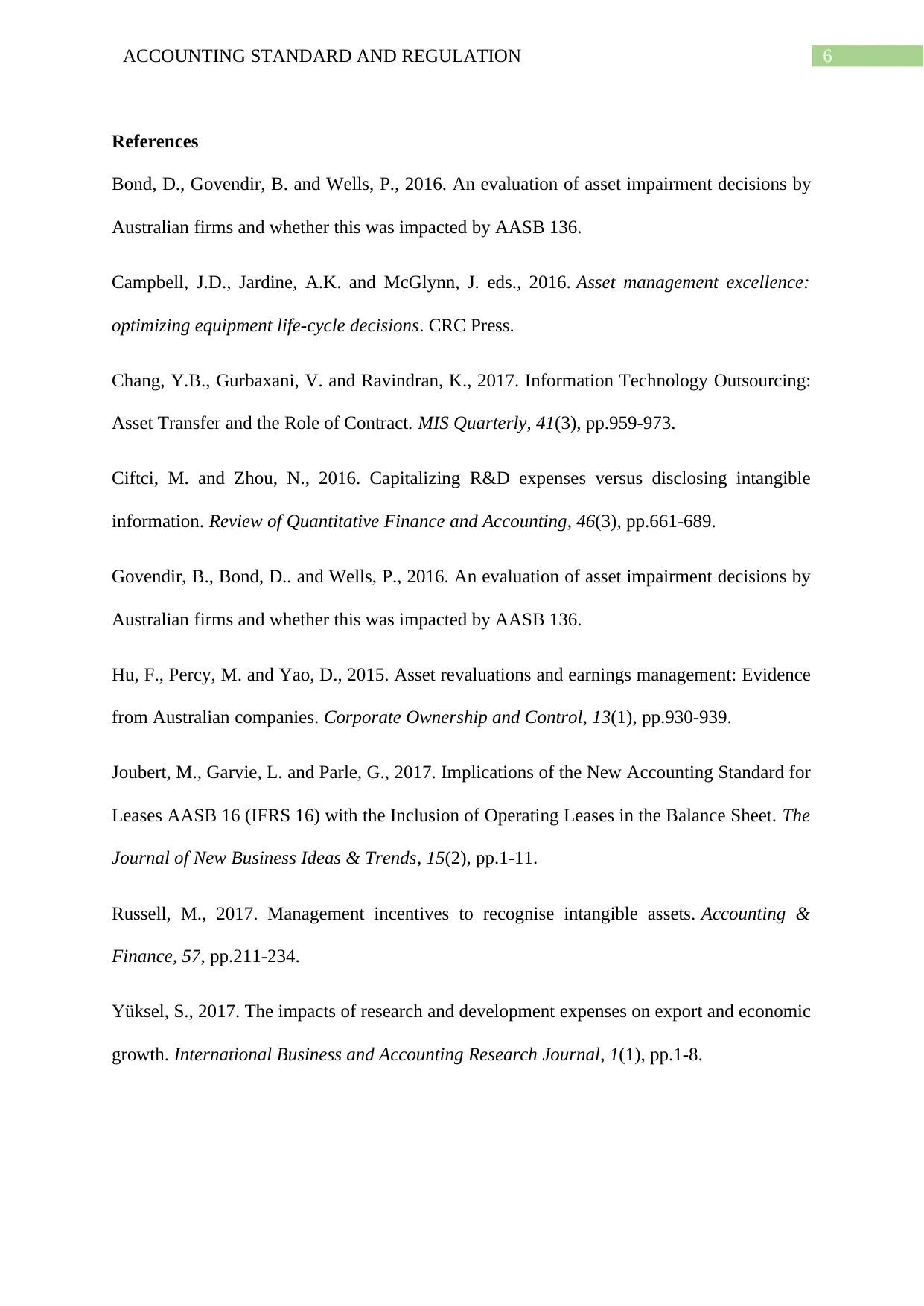
6ACCOUNTING STANDARD AND REGULATION
References
Bond, D., Govendir, B. and Wells, P., 2016. An evaluation of asset impairment decisions by
Australian firms and whether this was impacted by AASB 136.
Campbell, J.D., Jardine, A.K. and McGlynn, J. eds., 2016. Asset management excellence:
optimizing equipment life-cycle decisions. CRC Press.
Chang, Y.B., Gurbaxani, V. and Ravindran, K., 2017. Information Technology Outsourcing:
Asset Transfer and the Role of Contract. MIS Quarterly, 41(3), pp.959-973.
Ciftci, M. and Zhou, N., 2016. Capitalizing R&D expenses versus disclosing intangible
information. Review of Quantitative Finance and Accounting, 46(3), pp.661-689.
Govendir, B., Bond, D.. and Wells, P., 2016. An evaluation of asset impairment decisions by
Australian firms and whether this was impacted by AASB 136.
Hu, F., Percy, M. and Yao, D., 2015. Asset revaluations and earnings management: Evidence
from Australian companies. Corporate Ownership and Control, 13(1), pp.930-939.
Joubert, M., Garvie, L. and Parle, G., 2017. Implications of the New Accounting Standard for
Leases AASB 16 (IFRS 16) with the Inclusion of Operating Leases in the Balance Sheet. The
Journal of New Business Ideas & Trends, 15(2), pp.1-11.
Russell, M., 2017. Management incentives to recognise intangible assets. Accounting &
Finance, 57, pp.211-234.
Yüksel, S., 2017. The impacts of research and development expenses on export and economic
growth. International Business and Accounting Research Journal, 1(1), pp.1-8.
References
Bond, D., Govendir, B. and Wells, P., 2016. An evaluation of asset impairment decisions by
Australian firms and whether this was impacted by AASB 136.
Campbell, J.D., Jardine, A.K. and McGlynn, J. eds., 2016. Asset management excellence:
optimizing equipment life-cycle decisions. CRC Press.
Chang, Y.B., Gurbaxani, V. and Ravindran, K., 2017. Information Technology Outsourcing:
Asset Transfer and the Role of Contract. MIS Quarterly, 41(3), pp.959-973.
Ciftci, M. and Zhou, N., 2016. Capitalizing R&D expenses versus disclosing intangible
information. Review of Quantitative Finance and Accounting, 46(3), pp.661-689.
Govendir, B., Bond, D.. and Wells, P., 2016. An evaluation of asset impairment decisions by
Australian firms and whether this was impacted by AASB 136.
Hu, F., Percy, M. and Yao, D., 2015. Asset revaluations and earnings management: Evidence
from Australian companies. Corporate Ownership and Control, 13(1), pp.930-939.
Joubert, M., Garvie, L. and Parle, G., 2017. Implications of the New Accounting Standard for
Leases AASB 16 (IFRS 16) with the Inclusion of Operating Leases in the Balance Sheet. The
Journal of New Business Ideas & Trends, 15(2), pp.1-11.
Russell, M., 2017. Management incentives to recognise intangible assets. Accounting &
Finance, 57, pp.211-234.
Yüksel, S., 2017. The impacts of research and development expenses on export and economic
growth. International Business and Accounting Research Journal, 1(1), pp.1-8.
1 out of 7
Related Documents
Your All-in-One AI-Powered Toolkit for Academic Success.
+13062052269
info@desklib.com
Available 24*7 on WhatsApp / Email
![[object Object]](/_next/static/media/star-bottom.7253800d.svg)
Unlock your academic potential
Copyright © 2020–2025 A2Z Services. All Rights Reserved. Developed and managed by ZUCOL.





